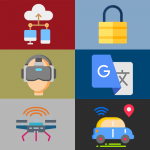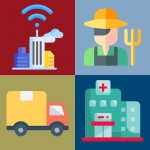5G is forecast to enable USD 12 trillion in new economic activity by 2035 and impact industries ranging from agriculture and forestry to finance and insurance. 5G has the potential to disrupt the way consumers, businesses and industries operate.
Before we jump into the disruptive potential of 5G, let’s look at what 5G is and how it is different from previous generations of mobile technology.
What is 5G technology?
5G, the fifth generation of broadband cellular network technology, is more than just an incremental step forward. It is a leap forward that will impact both consumers and businesses in significant ways. For example, mobile end-user devices, such as laptops, phones and tablets, will interact with the network more quickly, which means users will benefit from faster download speeds and instant messaging capabilities that feel instantaneous.
However, 5G is more than just an incremental step forward; it is by far the most significant shift in the history of mobile technology. To fully understand the considerable leap that 5G will usher in, let’s first discuss the preceding generations of mobile technology.
A brief history of mobile technology

In the 1990s, 2G introduced text (SMS) and multimedia messaging (MMS), adding a new form of communication. Shortly afterwards, 2.5G and 2.75G brought us mobile data, which opened up all kinds of new potential for mobile devices, including web browsing capabilities via wireless application protocol (WAP).
3G brought us increased data speeds, video calling, and improved mobile internet, and with these a vast expansion of the kinds of use cases where mobile technology could be applied.
4G brought us significantly faster data rates and by extension, gaming, HD mobile TV, video conferencing, and other data-intensive media experiences. News sites, YouTube, Facebook/Instagram, Airbnb and Uber, have all leveraged 4G’s mobile high-speed data transfer speeds to bring new offerings and business models to their customer bases.
| 2G | 3G | 4G LTE | 5G | |
| Era | 1991-2000 | 2000-2010 | 2010-2020 | 2020-2030 |
| Devices per Km2 | 100 | ~450 | 2,000 | 1,000,000 |
| Bandwidth | 25MHz | 25 MHz | 100 MHz | 1000x BW per unit area |
| Average Speed
(Megabits per second) |
0.1 Mbps | 3 Mbps | 20 Mbps | 500-700 Mbps |
| Peak Speed | 0.3 Mbps | 7.2 Mbps | 150 Mbps | 10-20 Gbps |
| Download Times (700MB) | 1.5 hours | 30 Mins | 11-12 mins | 9 Seconds |
| Latency(milliseconds) | 300-1000ms | 100-500ms | 20-30ms | 1-10ms |
In the chart above, we compare some key metrics for each mobile generation. If asked, most people would assume the decrease in the download time of 700MB of data from 1.5 hours on a 2G network to 9 seconds on 5G is the most significant improvement presented here. It isn’t, however, the most important number on this chart.
The most important number is 1-10ms latency.
What is low latency?
Latency is the time interval between stimulation and response. 5G features ultra-reliable low latency communications (URLLC). A mobile device can come out of a low power mode and respond to the network in less than 10ms and engage conversationally with the network in as little as 1ms.
Response time of less than a second is fast enough for humans to feel they can freely interact with information. Anything less than 100ms latency appears to be instantaneous. Human reaction time is about 250ms, and some extraordinary people – fighter pilots, race car drivers, and elite video gamers – can react in as little as 100ms.
Real-time latency is the time it takes for information to get from your eye or ear to your brain. It strips out the cognitive processing, context application and decision making. An image can hit your retina and travel down your optic nerve into the visual cortex in about 13ms. With a latency of less than 10ms, 5G latency is faster than human perception.
Why does low latency matter?
The increased responsiveness of low latency is critical when you consider a variety of use cases. For example, low latency will enable a surgeon in one location to control a pair of robotic arms performing a procedure in another location, a skilled operator to control machines in remote or hazardous environments, and autonomous vehicles to communicate in real-time.
These are just three examples of the myriad of new opportunities across a multitude of industries that 5G will enable. 5G’s ultra-reliability and low latency will usher in a new generation of breakout offerings and associated business models, some of which we will expand upon below.
Examples of how 5G will create new offerings and impact business models





V2V connectivity coordinated by network-based intelligence and traffic awareness will allow the system to collect situational information from both road-based sensors as well as other vehicle-based systems. As a result, vehicles will make better-quality decisions faster and can be instructed by the network on what is the best course of action.



The future of 5G
While faster download speeds tend to be the focus of consumer interest in 5G, it is the low-latency on 5G networks that will enable technologies to function with advanced capabilities that aren’t possible on 4G networks. 5G will be highly disruptive to many businesses across a multitude of industries. To find out how 5G could disrupt your industry, contact Burnie Group.
By: Douglas Heintzman, Innovation Practice Lead
Read our insights on 5G
Find out how you can improve your organization with technology and automation.
CONTACT US



